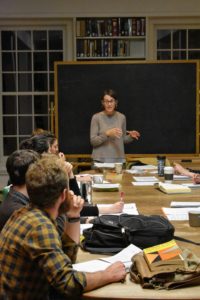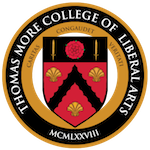By Ella Fordyce, Class of 2019
The tutorials at Thomas More College of Liberal Arts, offered for the junior and senior classes, vary in their subject material. This gives students the opportunity to specialize in whatever subject interests them most. Those who love the great outdoors may partake in President Dr. William Fahey’s Natural History tutorial, while those of a theological bent may take the Thomas Aquinas on Human Emotions tutorial with Father Thomas Crean. Of course, literature also holds a place of great honor in TMC’s curriculum; for this reason, Teaching Fellow Dr. Amy Fahey is once again offering her Short Story tutorial.
 In this class, students read short stories ranging from ancient tales to modern compositions, from nameless storytellers to contemporary authors. They study the various forms of short stories, including parables, fables, and saints’ lives. Of course, with such a broad scope, there are many angles from which to approach the study, such as the culture or genre of the stories. Mrs. Fahey, however, chose to approach the selected stories as chronicling the shift from oral to written stories. This is only fitting, given that all storytelling was originally an oral art form.
In this class, students read short stories ranging from ancient tales to modern compositions, from nameless storytellers to contemporary authors. They study the various forms of short stories, including parables, fables, and saints’ lives. Of course, with such a broad scope, there are many angles from which to approach the study, such as the culture or genre of the stories. Mrs. Fahey, however, chose to approach the selected stories as chronicling the shift from oral to written stories. This is only fitting, given that all storytelling was originally an oral art form.
The students began their studies by reading two very different sets of oral stories: Peig Sayers’ An Old Woman’s Reflections and the parables of Jesus Christ. These two represent different ends of a storytelling timeline. Jesus spoke his parables at a time when almost all stories were told aloud; Peig’s stories were recorded as oral storytelling in Ireland was becoming a lost art. As such, Peig’s tales provide valuable insight into Irish culture, in particular regarding the people of the now-abandoned Blasket Islands. The parables, of course, serve not as insight into Jewish culture, but rather offer morals touching upon the Kingdom of Heaven. These different stories demonstrate that, apart from any entertainment value, short stories are capable of educating in many various ways.
Next, the students read the Icelandic saga of Frey’s Godi and Joel Chandler Harris’ Uncle Remus stories. Both of these stories, though they have been preserved in written format, would originally have been told aloud. Mrs. Fahey led the class in a discussion of Icelandic culture and law as witnessed in the sagas, as well as their famously dark, understated humor. After that, the class discussed the merits of using anthropomorphized animals as main characters, as is done in the Uncle Remus stories. Making the characters animals with a few specific traits gives the storyteller the opportunity to speak of universal truths without delving into particular character development. Thus, the animals in the Uncle Remus tales are a particular kind of stock character.
An advantage of studying short stories over longer novels is that, given their condensed form, one can read a far greater selection in less time. These stories can provide varied insight into different times and places. For authors, the challenge that a short story presents necessitates the ability to craft an interesting story in limited space. Capturing a beautiful story over the course of several hundred pages is already difficult; capturing a beautiful story over the course of two pages is a different matter altogether. Through the course of studies arranged by Mrs. Fahey, the students taking the Short Story tutorial have the opportunity both to learn of multiple different cultures and peoples, and to appreciate the complex art form that is the short story.
For further reading:
